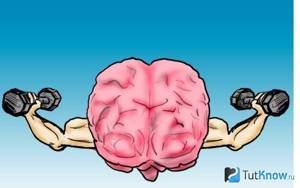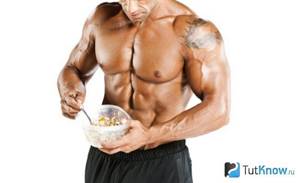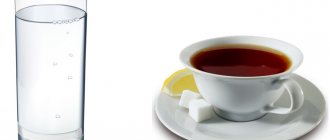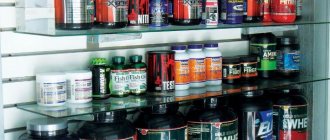What is it in bodybuilding
Professional bodybuilding athletes have long understood that focusing on the working muscle during exercise can significantly improve progress. Arnold Schwarzenegger also paid special attention to this, talking about the techniques he used to obtain the required concentration. Today, the connection between the brain and muscles has many scientific justifications and is not the prerogative of only professional athletes. Even beginners can develop this connection, resulting in rapid gains in muscle, endurance, and even strength.
The brain-muscle connection is always used to perform every movement. However, it can be strengthened and this is where the main advantage lies. Two types of communication play the greatest role in sports:
- Intermuscular - The central nervous system simultaneously uses different muscles to perform a movement. For example, antagonist muscles or different groups when performing basic exercises.
- Intramuscular – the ability to involve the maximum number of muscle fibers into work. It is this type of neural connection that provides the best results in training.
For example, if an athlete is performing rigorous biceps curls, the brain may only be recruiting 50-60% of the total fibers, especially if there are enough fibers to handle the selected weight in the current regime. However, focusing on a specific muscle can increase fiber recruitment rates by up to 70-80% or even more, making each set more effective even without changing the conditions (same weight, same number of reps).
Neuromuscular connection - what is it?
Neuromuscular communication is the conscious ability to feel your muscles and increase their level of engagement when performing exercises. It is the developed neuromuscular connection that distinguishes a beginner who lifts weights using the force of inertia from a professional athlete who uses the body’s capabilities to 100%. Ultimately, the muscle-brain connection helps you train effectively.
To improve neuromuscular communication, it is also necessary to take into account the fact that there are different types of muscle fibers. Slow (red) fibers develop during static exercises, while fast (white) fibers increase their strength during dynamic exercises performed correctly. When training, it is necessary to combine different types of loads.
Professional bodybuilding also pays attention to the development of neuromuscular connections - this is what allows you to pose in competitions and consciously tense certain muscle groups. In particular, this is especially important for the volume of the arms and chest. A role is also played by the fact that in the absence of a connection between the muscles and the brain, the symmetry of the body is disturbed - which is undesirable for bodybuilders.
// What does the neuromuscular connection provide:
- Ability to consciously tense muscles
- More correct exercise performance
- Improving muscle symmetry
Functional training
Since the development of neuromuscular connections is associated with conscious exercise, functional training is better suited for this than strength training equipment. For example, when doing pull-ups on a bar, an athlete learns to involve the latissimus dorsi muscles in the work, while when performing lat pull-downs in a machine, many beginners pull the weight exclusively with arm strength.
In fact, strength training with excessively heavy weights only worsens the neuromuscular connection, and does not develop it at all. The desire to train “to failure” (when there is no strength left for the last repetition) significantly increases the risk of injury - although, in theory, this should create stress that provokes hypertrophy processes and causes muscle growth.
How does it affect muscle growth?
Muscle recruitment and response to load is the main reason for muscle growth. That is, the task for developing muscle mass is to provide an ever-increasing load, which will force the muscles to “adjust” to the conditions. Developing neuromuscular connections is a way to increase muscle recruitment even without using heavy weights.
For example, perform a set of standing or seated biceps curls with dumbbells as usual. Mark the point where muscle failure occurred. After this, give the biceps a complete rest and perform a set with the same weight, but concentrating the load on the biceps. You will find that fatigue sets in much earlier. This is because while performing a movement you “feel” a specific muscle and force it to work to its maximum. It is this skill that allows professional athletes to work specific areas or even bundles in basic movements, which is almost impossible for a beginner who will press or pull with the entire muscle mass.
How can you strengthen the brain-muscle connection in bodybuilding?

According to everything written above, bodybuilders cannot be called “dumb”. The brain works very actively during training. Everyone knows that bodybuilding has three main components:
- Constant physical exercise;
- Organization of necessary nutrition and diets;
- Frequent recovery of the body.
All these components directly affect the development of the mental brain-muscle connection in bodybuilding. Each of these components should be discussed in a little more detail.
Brain and exercise

It should be remembered that all types of physical activity have a positive effect on the brain. Thanks to them the following happens:
- Blood flow and, accordingly, brain nutrition improves;
- Improves mood and reduces stress;
- Brain waste is disposed of faster.
To fully pump up mental connections, 3 to 5 training sessions per week are enough. At least two of them must involve cardio exercise.
Brain and nutrition

There are foods that have a positive effect on brain performance. Among them, blueberries, fatty fish, lean meat, whole grain bread and bran, dairy products, nuts, broccoli, and avocado should be highlighted. When consuming all these foods, the brain begins to function more actively, which helps to strengthen the mental connections between the muscles and the brain.
How to develop neuromuscular communication
Developing and improving neuromuscular communication is a fairly simple but lengthy process. However, it will bear fruit and increase the effectiveness of the training from the very beginning of training.
Work without weight
First, you need to start developing your brain-muscle connection without weights. Learn to tense every muscle, learn to control your body, this is the basis for increasing neuromuscular communication. For example, try tightening your left and right pectoral muscles alternately. You will likely find that focused tension is very difficult to achieve, and that attempting to tension an area will activate the entire circuit. This happens because the brain has not been “taught” to tense each muscle separately. Do these workouts 1-2 times a day, preferably in the morning and evening.
Control the pace
The second important aspect is the correct tempo. If you perform a movement quickly or explosively, neuromuscular control is out of the question. To develop this skill, try to perform each repetition at a slow and steady pace, without jerking or speeding up (especially in the negative phase).
Don't chase weight
While strengthening the brain-muscle connection, you should not increase your weight. Even if the first approaches are easy for you at first, use medium weights (no more than 40-50% of 1RM). In this case, the quality of the cuts is significantly higher than the weight used. With the right approach, even with a weight of 30-40% of 1RM, you will feel a powerful load and quickly reach failure.
Regularity
The most important point is regularity. The body only uses what is used regularly. Therefore, it is necessary to treat training with neuromuscular control as a specific technique that is aimed at improving certain skills and the ability to better use the muscle.
neuromuscular connection
neuromuscular connection - today I will talk about what it is and how to develop it. neuromuscular connection is very important. Thanks to it, we can train more effectively with less weight. It is the neuromuscular connection that forces us to change our training programs every few weeks. In a word, even Tarantino and Uma Thurman will tell you about it...
So, the video “neuromuscular connection” is, as always, at the end of the article, and we’ll get started!
Neuromuscular connection as an example.
Let's take a look at a newbie who has just started pumping. So the coach shows him how to bench press the barbell, he lies down on the bench and... the barbell begins to move left and right, up and down, after the approach his hands tremble, although the weight was small - an empty bar. The reason is neuromuscular connection. Let's look at the same guy in a couple of months - he already benches the barbell twice as hard, but the volume of his muscles has practically not changed. Why ? For the same reason - neuromuscular connection. And finally, let's look at the same guy if he became an athlete 10 years later. He is huge, but is able to pump muscles with much less weight than his smaller colleagues. How does he manage to do this? The answer is still the same - neuromuscular connection. So first, a little theory:
neuromuscular connection
Neuromuscular connection. Science.
Neuromuscular communication is how the brain controls our muscles. First, the impulse is transmitted from the brain to the so-called motor neuron, which are located in the spinal cord. From the motor neuron to the muscle fiber, the impulse moves along the axon - a long nerve, the end of which branches and each hair of which is responsible for a separate muscle fiber. Now remember that muscles consist of bundles of muscle fibers. So one motor neuron is responsible for several fibers - all this together is called a motor unit. And for the entire muscle there is a set of motor neurons. And this is where the fun begins. Different motor neurons respond to impulses from the brain of different frequencies. Our body tries to complete any work with as little cost as possible. In order to lift an empty teapot and a full one, different efforts are required. The higher the frequency of the impulse sent from the brain to a set of motor neurons, the greater the number of fibers we can control or, as they say, recruit for work. So training or the development of neuromuscular communication is the adaptation of our brain to control motor neurons. The better this connection, the more muscle fibers we can force to work, and therefore train.
Neuromuscular connection. What does it affect?
Yes, if you don’t feel a muscle, you’re not training it. Feeling muscles means being able to control them. For example – can you move your ears as you wish? I have a well-developed neuromuscular connection, so I can do this (see video) I can move my ears even when I'm talking to you. And can you ? It’s the same with the muscles you work – they always give the example of the pectorals. Can you move your right and left pectoralis separately? (see video) Those who can do this have a more trained neuromuscular connection than those who cannot.
This is the reason why an experienced athlete can pump his muscles with less weight - he deliberately forces a larger number of fibers in each muscle to contract and work, because a larger number of motor neurons are available to his control. This is the reason why in the first months beginners get the impression that they are simply super pumped up - they begin to feel the muscles. This is why there is an increase in working weights without a particularly noticeable increase in muscle size - the body tries to connect more and more fibers instead of growth.
neuromuscular connection and program.
This is the reason why the training program needs to be changed every 3-6 weeks and the more experience, the more often. The body tries to optimize its work so that it doesn’t have to build new fibers - it really doesn’t like this and within a few weeks it “gets used” to the training program and stops growing. As it gets used to it, it optimizes work with the load by optimizing neuromuscular connections.
So, I hope I have convinced you of the paramount importance and necessity of developing neuromuscular communication. So how will we do this? Write down:
How to train neuromuscular connection.
- Concentrate on sensations while performing exercises. Don't chase huge weights. While doing this, try to feel and additionally tense the muscles you are training. Your body will try to make it easier to do the exercises, and you CONSCIOUSLY need to make it difficult.
- Train mentally at any time. Mentally perform exercises while driving, in a minibus, before going to bed - anywhere. Do you know what this looks like? Like how Uma Thurman in the movie “Kill Bill”, after lying in a coma for several years, learns to walk again in the rapist’s car. He orders himself: “move your left toe.” This is roughly how you need to force your muscles to contract at any convenient time.
- Be prepared to spend time. Believe me, it's not always fast. Igor Gostyunin once mentioned a few years ago that he had just begun to feel the muscles. And by the time he said this, he was already a famous athlete, having trained for six years with none other than Alexander Vishnevsky.
So, in the end, it’s the same thing I’ve always said: don’t stress about the result. Make it a way of life and then the result will come unnoticed, will be stunning and will stay with you not until the end of your vacation, but for the rest of your life. Share this material with your friends, like it and don’t forget to subscribe to my channel - about how to start a new life on Monday and not give it up on Tuesday. And that’s all for today, Basilio was with you, bye everyone.
Neuromuscular connection video.
How to train the connection between the brain, nerves and muscles?
An experienced athlete can tense an entire muscle group with one psychological effort. How to learn such concentration?
Developed neuromuscular connection is the result of long training. Over time, the nervous system learns to better recruit muscle fibers and more accurately use combinations of different muscles. At the same time, you should not focus on individual feelings. For example, thinking that the connection is not being developed when you do not feel the “movement” of the muscle. This sensitivity is determined by genetics and depends on the amount of neurotransmitters. Although it is much more pleasant to feel the muscles working, the neuromuscular connection develops without this feeling.
For the effectiveness of developing this connection, the pace of training is important. Medium speed is best. If you perform movements abruptly, the brain will not have time to “record” the work of the muscles due to the rapid change of nerve impulses. In addition, there is no need to chase the maximum weight. It is better to work on technique with medium weight. This way you will gradually achieve mastery of the movements, which means you will develop muscle memory.
Deltoid training
Key points:
Focus on moving your elbows, use gravity as much as possible, and keep your core tense at all times.
Activating exercises are trisets of arm raises with light dumbbells (in front of you, across the sides, in an incline) and variations of bench presses in a standing position.
https://www.youtube.com/watch?v=ytdev
Press standing or sitting. Everything is the same as with the bench press. This means pushing with your elbows and intending to bring your palms together if you are pressing a barbell, and intending to close your elbows if you are pressing dumbbells. Your forearms should remain perpendicular to the floor. A “lockout” at the top will force the triceps to actively engage, so it makes sense to stop in time. The slow eccentric phase of the rep will make your delts burn.
READ MORE: Rotations and tilts of the neck, how to correctly perform tips
Dumbbell raises. Do them while sitting to avoid the temptation to ease your work with inertia. Straighten your chest, lift your chin, and move your shoulders back. If you want to load the lateral deltoids, then remember that they should look up. Keep in mind that gravity pulls the dumbbells only towards the floor, so the deltoids are properly engaged only starting from the middle of the amplitude. Try doing cable raises. In this case, the deltoids will remain in tension throughout the entire range of movement.
What is the mental brain-muscle connection?
Many athletes do not pay due attention to this issue, and for this reason it is worthwhile to dwell a little more on the connection mechanism. Surely many have seen and even experienced it when, when performing exercises, the body behaves asynchronously, the hands shake, and the barbell lowers and rises convulsively. All this is typical for beginners and everyone goes through it.
READ MORE: Yoga classes for beginners 10 best asanas for beginners at home
https://www.youtube.com/watch?v=https:tv.youtube.com
In most cases, the reason for this is not the large working weight of the sports equipment, but rather the weak connection between the brain and muscles. The channel transmitting the nerve impulse is very weak and even if a person knows how to perform the movement correctly, it will be very difficult to do so.










